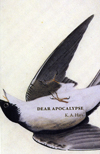Dear Apocalypse
Dear Reader,
Dear Reader,
Please read Dear Apocalypse. Please read it carefully, with attention to talons, to feathers, to the complicated ways of both God and migratory pathways. (Perhaps they’re the same thing? Perhaps K.A. Hays thinks they’re the same thing?)
You don’t have to start at the beginning. But if you don’t, you’ll miss Hays’s apocalypse, flayed out and intellectually parsed in her “Letters” section. Everything after that is the aftermath and fall-out, including the hands-on Middle Western earthiness of the “Labors” section, and the slow mental withdrawal of the “Mind” section. Finally, all that are left are the birds, flitting over disaster or weightlessly succumbing to it.
These birds of hers aren’t the canaries that died as little warning flares in our mines. They’re the flags left flying after the dust settles, and it’s their rustling and unease that gives this collection of poetry its loft and tension. These are poems concerned with airspace and the spaces within the mind.
Consider one of the poems I most believe in, “Letter from the End of the World.” I’m betraying the power and craft of the poem’s set-up by giving away the ending, but I’m going to do it anyway.
Meridians, you who guided and lulled us,
we accuse you.
Your spins left circular runnels
in the sky, through which we can see the great arbiter,
as bland and ready as a cast-iron pan – in whose image
we fear, squinting, we were not made.
There’s an admirable precision of language here, and the force of a powerful image, the banding meridians, peeling back to confront us with what we do not even believe. Note how Hays slips “squinting” into that last line. Gorgeous!
This is poetry positing birds as prophets, and humans as just another disorderly flock upon the planet. “Some think after our extinction / earth might be calm – but I doubt it,” Hays claims in “Letter from the Afternoon.” And we’re inclined to believe her. We, too, may feel like sitting down with her to “talk epistemology with something ugly/and inanimate: the earth, for example.”
The earth itself and what grows upon it and lives there become Hay’s way to interpret our own mindsets and meanings. She hints that it may be better to go through life like a turtle, piled in mud upon other turtles “to stay alive by being nearly dead,” instead of being dragged under like a hapless duck floating upon the clear surface.
Loss and rot – and not just random accident – become themes as well, precisely conveyed in images as neat as the split-heart footprint a passing buck leaves in the snow. They’re even wished for, as when Hays begs in “Exodus” for “any mass / rebellion of the quiet functioning things.” These are poems with impact and after-shock that awe with their precision.
If they fail at all, it’s towards the end, when Hay’s images and references begin to fade into catalogues closer to a bird-watcher’s life list than fully realized poems imbued with the meaning instilled in the earlier sections. A few weaker poems attempt to blend pilgrimages, religious imagery, and birds, but when dealing with some of these often-cited themes, the poems and symbols fail to crystallize or surprise.
Even then, though, Hays’s language stuns. Tea is “peppery gold clairvoyance”; swans are “plump and unholy, loaded up / with bone and blood and pipes / that allow, for the moment / their thousand piccolo calls / and the mess that pours through them.”
The language is the light bone inside these poems, and this flock of poems is going to fly a long way. Listen to them before they’re gone!





